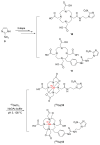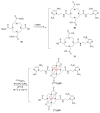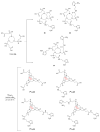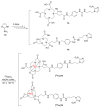Recent Advances of 68Ga-Labeled PET Radiotracers with Nitroimidazole in the Diagnosis of Hypoxia Tumors
- PMID: 37445730
- PMCID: PMC10342082
- DOI: 10.3390/ijms241310552
Recent Advances of 68Ga-Labeled PET Radiotracers with Nitroimidazole in the Diagnosis of Hypoxia Tumors
Abstract
Positron emission tomography (PET) is a noninvasive molecular imaging method extensively applied in the detection and treatment of various diseases. Hypoxia is a common phenomenon found in most solid tumors. Nitroimidazole is a group of bioreducible pharmacophores that selectively accumulate in hypoxic regions of the body. Over the past few decades, many scientists have reported the use of radiopharmaceuticals containing nitroimidazole for the detection of hypoxic tumors. Gallium-68, a positron-emitting radioisotope, has a favorable half-life time of 68 min and can be conveniently produced by 68Ge/68Ga generators. Recently, there has been significant progress in the preparation of novel 68Ga-labeled complexes bearing nitroimidazole moieties for the diagnosis of hypoxia. This review provides a comprehensive overview of the current status of developing 68Ga-labeled radiopharmaceuticals with nitroimidazole moieties, their pharmacokinetics, and in vitro and in vivo studies, as well as PET imaging studies for hypoxic tumors.
Keywords: Ga-68; PET; hypoxia; radiopharmaceuticals; tumor.
Conflict of interest statement
The authors declare no conflict of interest.
Figures











Similar articles
-
[(68) Ga]-HP-DO3A-nitroimidazole: a promising agent for PET detection of tumor hypoxia.Contrast Media Mol Imaging. 2015 Nov-Dec;10(6):465-72. doi: 10.1002/cmmi.1649. Epub 2015 Jun 29. Contrast Media Mol Imaging. 2015. PMID: 26122548 Free PMC article.
-
68Ga-labeled PET tracers for targeting tumor hypoxia: Role of bifunctional chelators on pharmacokinetics.Nucl Med Biol. 2021 May-Jun;96-97:61-67. doi: 10.1016/j.nucmedbio.2021.03.004. Epub 2021 Mar 26. Nucl Med Biol. 2021. PMID: 33838524
-
Development of (68)Ga-labeled multivalent nitroimidazole derivatives for hypoxia imaging.Bioorg Med Chem. 2015 Dec 15;23(24):7743-50. doi: 10.1016/j.bmc.2015.11.024. Epub 2015 Nov 22. Bioorg Med Chem. 2015. PMID: 26643217
-
Recent Developments in PET and SPECT Radiotracers as Radiopharmaceuticals for Hypoxia Tumors.Pharmaceutics. 2023 Jun 27;15(7):1840. doi: 10.3390/pharmaceutics15071840. Pharmaceutics. 2023. PMID: 37514026 Free PMC article. Review.
-
An overview of the developments and potential applications of 68Ga-labelled PET/CT hypoxia imaging.Ann Nucl Med. 2021 Feb;35(2):148-158. doi: 10.1007/s12149-020-01563-7. Epub 2021 Jan 5. Ann Nucl Med. 2021. PMID: 33400147 Review.
Cited by
-
Recent Progress in Synthesis of 99mTc-labeled Complexes with Nitroimidazoles as SPECT Probes for Targeting Tumor Hypoxia.Nucl Med Mol Imaging. 2024 Aug;58(5):258-278. doi: 10.1007/s13139-024-00860-7. Epub 2024 Apr 25. Nucl Med Mol Imaging. 2024. PMID: 39036459 Free PMC article. Review.
References
Publication types
MeSH terms
Substances
Grants and funding
LinkOut - more resources
Full Text Sources
Miscellaneous

